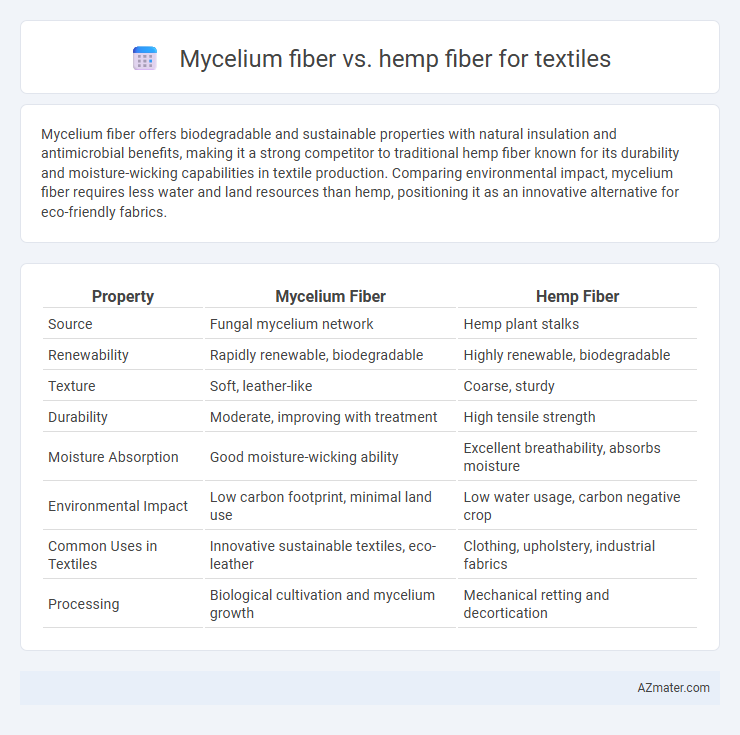Mycelium fiber offers biodegradable and sustainable properties with natural insulation and antimicrobial benefits, making it a strong competitor to traditional hemp fiber known for its durability and moisture-wicking capabilities in textile production. Comparing environmental impact, mycelium fiber requires less water and land resources than hemp, positioning it as an innovative alternative for eco-friendly fabrics.
Table of Comparison
| Property | Mycelium Fiber | Hemp Fiber |
|---|---|---|
| Source | Fungal mycelium network | Hemp plant stalks |
| Renewability | Rapidly renewable, biodegradable | Highly renewable, biodegradable |
| Texture | Soft, leather-like | Coarse, sturdy |
| Durability | Moderate, improving with treatment | High tensile strength |
| Moisture Absorption | Good moisture-wicking ability | Excellent breathability, absorbs moisture |
| Environmental Impact | Low carbon footprint, minimal land use | Low water usage, carbon negative crop |
| Common Uses in Textiles | Innovative sustainable textiles, eco-leather | Clothing, upholstery, industrial fabrics |
| Processing | Biological cultivation and mycelium growth | Mechanical retting and decortication |
Introduction to Mycelium and Hemp Fibers
Mycelium fiber, derived from the root structure of fungi, offers a sustainable and biodegradable alternative to traditional textile fibers, characterized by its natural breathability and antimicrobial properties. Hemp fiber, obtained from the stalks of the Cannabis sativa plant, is renowned for its strength, durability, and resistance to UV light and mold, making it a popular choice in eco-friendly textile production. Both fibers provide renewable resources with distinct environmental benefits, positioning them as promising materials in the shift toward sustainable fashion and textiles.
Origins and Production Processes
Mycelium fiber, derived from the root structure of fungi, is cultivated by growing fungal mycelium on organic substrates through a controlled fermentation process, resulting in a biodegradable and sustainable textile material. Hemp fiber originates from the stalk of the Cannabis sativa plant, harvested, retted, and mechanically processed to extract strong, durable bast fibers commonly used in eco-friendly textiles. Both fibers embody distinct biological origins and production methods, with mycelium emphasizing fungal cultivation innovations and hemp relying on traditional agricultural and mechanical extraction practices.
Environmental Impact Comparison
Mycelium fiber and hemp fiber both offer sustainable alternatives to conventional textiles, but hemp fiber has a more established environmental profile with its low water usage, rapid growth cycle, and natural pest resistance reducing the need for chemical inputs. Mycelium fiber, derived from fungal mycelium, is biodegradable and can be produced with minimal land use and lower carbon emissions, presenting a promising option for reducing textile industry pollution. However, hemp fiber's scalability and long-standing agricultural benefits currently make it a more impactful choice in large-scale sustainable textile production.
Physical Properties and Strength
Mycelium fiber exhibits lightweight characteristics with moderate tensile strength and excellent biodegradability, making it a sustainable alternative in textile applications. Hemp fiber demonstrates superior physical durability, high tensile strength, and natural resistance to abrasion and mold, contributing to its widespread use in heavy-duty textiles. The structural cellulose content in hemp fibers provides enhanced elasticity compared to the more brittle mycelium fibers, influencing their respective performance in textile manufacturing.
Sustainability and Renewability
Mycelium fiber offers exceptional sustainability due to its rapid growth, low resource requirements, and biodegradability, making it a promising alternative to traditional textiles. Hemp fiber is highly renewable, requiring minimal water and pesticides, and contributes to soil health through phytoremediation and carbon sequestration. Both fibers provide eco-friendly options, but mycelium's cultivation speed and waste-to-material potential enhance its appeal in the circular textile economy.
Biodegradability and End-of-Life Options
Mycelium fiber and hemp fiber both offer strong biodegradability, with mycelium breaking down faster due to its fungal origin, typically decomposing within weeks under composting conditions. Hemp fiber, sourced from the stalks of the Cannabis sativa plant, biodegrades naturally over several months and has well-established composting and recycling end-of-life options. Both fibers support sustainable textile production by minimizing landfill waste, but mycelium's rapid decomposition provides a more accelerated return to the soil ecosystem.
Applications in Textile Industry
Mycelium fiber offers innovative applications in the textile industry due to its biodegradability, flexibility, and sustainable production process, making it ideal for eco-friendly fashion and accessories. Hemp fiber remains a staple in textile manufacturing for its durability, moisture-wicking properties, and resistance to UV light, widely used in apparel, upholstery, and industrial fabrics. Combining mycelium and hemp fibers could enhance textile performance by merging strength and sustainability for future fashion and technical textiles.
Cost Analysis and Market Availability
Mycelium fiber offers a cost-effective alternative to hemp fiber, benefiting from faster cultivation cycles and lower resource input, which reduces production expenses significantly. Hemp fiber, while slightly more expensive due to established farming and processing infrastructure, maintains strong market availability driven by well-developed supply chains and consumer demand for sustainable textiles. Market analysis indicates mycelium fiber is rapidly gaining traction as a scalable and affordable option in textile manufacturing, though hemp remains dominant in current commercial applications.
Innovations and Future Potential
Mycelium fiber offers groundbreaking bio-fabrication techniques that enable sustainable, biodegradable textiles with customizable properties, positioning it as a revolutionary material in the fashion industry. Hemp fiber, known for its durability, breathability, and natural antimicrobial qualities, benefits from advancements in eco-friendly processing and blending technologies enhancing its application in high-performance textiles. Both fibers drive innovation in sustainable fashion, with mycelium's rapid growth and renewability complementing hemp's robust mechanical strength and environmental resilience, signaling transformative potential for future eco-conscious textile manufacturing.
Conclusion: Choosing the Right Fiber for Textiles
Mycelium fiber offers sustainable and biodegradable qualities with a soft, leather-like texture ideal for eco-friendly fashion, while hemp fiber provides durability, breathability, and antimicrobial properties suited for long-lasting textile applications. Selecting the right fiber depends on specific textile needs such as flexibility, environmental impact, and durability requirements. For sustainable, innovative textiles with a unique finish, mycelium fiber is preferable, whereas hemp excels in strength and traditional textile uses.

Infographic: Mycelium fiber vs Hemp fiber for Textile
 azmater.com
azmater.com